Dec 8, 2017
In October of this year, The Mount Sinai Hospital announced the opening of the new cardiac unit, the former Cardiac Care Unit (CCU), now located on KCC 6 in the Klingenstein Clinical Center. There are 20 beds, ten of which are the Cardiac Intensive Care Unit (CICU) and ten are step-down beds, the Cardiac Step Down Unit (CSDU). Unlike the other ICU units, the ten ICU beds are all private rooms. The entire unit is beautiful, with a receptionist desk as you get off the elevator.
It just so happens that last year, the Aufses Archives received a small set of papers from Barbara McPeek Mulhearn, RN, Class of 1962 of The Mount Sinai Hospital School of Nursing. Among those items was information about Mulhearn’s role in creating the first Cardiac Care ICU at the Hospital, which opened in 1968. Her title was Assistant Nursing Supervisor in charge of the Ames Coronary ICU, an eight bed unit on the 4th floor of KCC. The Unit opened February 19, 1968.
Shown below are two pieces from the collection: a drawing of a heart held in a person’s hands with the poem “Invictus” by William Ernest Henley typed over it. This was sent to Mulhearn from “her first I.C.C.U. staff,” in appreciation from them “and the many patients you will help along the way.” Also shown here is a letter from Dr. Cynthia Kinsella, the Director of Nursing at The Mount Sinai Hospital at the time, thanking Mulhearn for her efforts and encouraging her as they neared the Unit opening.
Fifty years on, the caring legacy continues.

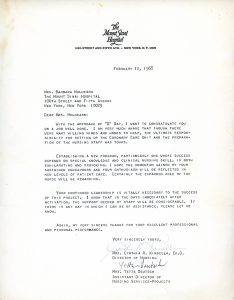
Sep 29, 2017
As the repository for the historical records of the seven Mount Sinai Health System hospitals, the Arthur H. Aufses, Jr. MD Archives has an extensive collection of historical photographs, many of which are available to view in our Image Database. Sometimes, however, the photographs in our collection have no information that would give them context. These photographs of the Beth Israel Medical Center house staff in the 1950s and 1960s arrived at the Archives as part of an unorganized collection of slides that we have been hard at work arranging and cataloging. While we can tell that they are photographs of the house staff, and can recognize that most of them were taken on the roof of the Dazian Pavilion, we don’t know the names of any of the doctors. Do you? If so, contact the Archives and let us know!
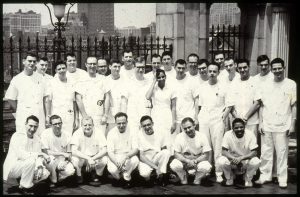 The 1958 Beth Israel house staff on the roof of the Dazian Pavilion
The 1958 Beth Israel house staff on the roof of the Dazian Pavilion
 The Beth Israel house staff of an unidentified year (early 1960s?) on a hospital ward
The Beth Israel house staff of an unidentified year (early 1960s?) on a hospital ward
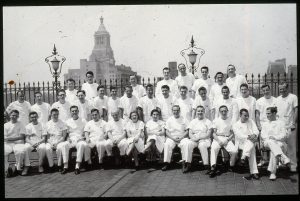 The Beth Israel house staff of an unidentified year (late 1950s?) on the roof of the Dazian Pavilion
The Beth Israel house staff of an unidentified year (late 1950s?) on the roof of the Dazian Pavilion
 The Beth Israel house staff of an unidentified year (early 1960s?) and other Beth Israel doctors/administrators on the roof of the Dazian Pavilion
The Beth Israel house staff of an unidentified year (early 1960s?) and other Beth Israel doctors/administrators on the roof of the Dazian Pavilion
Jun 8, 2017
The Arthur H. Aufses, Jr. MD Archives recently received a copy of the 1957 Mount Sinai Nursing Department Manual of Nursing Procedures from Gail Singer Lyon, member of the Class of 1962 of The Mount Sinai Hospital School of Nursing. Manuals like these have value because they show what the patient experience and medical care were like then, and they provide a sense of what the duties of a nurse were at a given point of time. The Archives has many such manuals from 1931 up to the present day, and they provide great information on how nursing, medicine, and hospitals have changed over this span.
While the Archives has other copies of this edition of the Manual, what makes this copy special are the extras that Ms. Lyon has included with her volume, from inserts to doodles. The manuals were given to the students to govern their practice when they were in the clinical areas of the Hospital. It includes detailed instructions on everything from Abdominal Binders to Wall Suction, Method of Using. Throughout the Manual, when it is necessary to provide examples using the names of doctors, the procedures referred to them as Dr. Roe and Dr. Moe. The patient is, of course, John or Jane Doe. Ms. Lyon wrote hints and additional information on the pages of her volume, and also inserted forms and updates to the policies.
This post highlights some of those ‘extras’ that make this volume interesting.

This form shows the communications technology of the time. Note the bottom row for how a family would be reached in time of emergency.
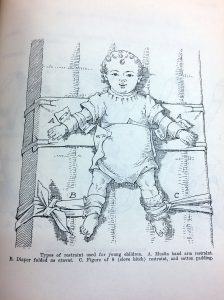
A lovely drawing showing how to restrain a child

A doodle, clearly showing a woman wearing a Mount Sinai Hospital School of Nursing cap, with is many pleats in the front.
May 8, 2017
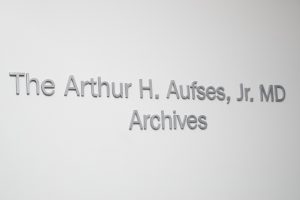 On April 26, 2017, the Mount Sinai Archives celebrated its dedication as The Arthur H. Aufses, Jr. MD Archives. This re-naming was in grateful recognition of the long-time support and dedication of Dr. Arthur Aufses and Mrs. Harriet Aufses. The Archives houses historical collections from the Icahn School of Medicine and the seven hospitals within the Mount Sinai Health System, with collections comprised of paper records, photographs, artifacts, memorabilia, and digital records—measuring 2,700 linear feet of history. The oldest records date to the 1840s and new records – paper and electronic – are added every day. The hospitals represented in the collection are: The Mount Sinai Hospital, Mount Sinai Beth Israel Hospital, Mount Sinai St. Luke’s Hospital (including the Woman’s Hospital), Mount Sinai West (formerly the Roosevelt Hospital), Mount Sinai Queens, Mount Sinai Brooklyn, and the New York Eye and Ear Infirmary of Mount Sinai.
On April 26, 2017, the Mount Sinai Archives celebrated its dedication as The Arthur H. Aufses, Jr. MD Archives. This re-naming was in grateful recognition of the long-time support and dedication of Dr. Arthur Aufses and Mrs. Harriet Aufses. The Archives houses historical collections from the Icahn School of Medicine and the seven hospitals within the Mount Sinai Health System, with collections comprised of paper records, photographs, artifacts, memorabilia, and digital records—measuring 2,700 linear feet of history. The oldest records date to the 1840s and new records – paper and electronic – are added every day. The hospitals represented in the collection are: The Mount Sinai Hospital, Mount Sinai Beth Israel Hospital, Mount Sinai St. Luke’s Hospital (including the Woman’s Hospital), Mount Sinai West (formerly the Roosevelt Hospital), Mount Sinai Queens, Mount Sinai Brooklyn, and the New York Eye and Ear Infirmary of Mount Sinai.
For additional information about The Arthur H. Aufses, Jr. MD Archives, please contact the staff at msarchives@mssm.edu. The Aufses Archives are a part of the Academic Informatics and Technology area, which includes the Gustave L. and Janet W. Levy Library, the Instructional Technology Group, and Academic and Research IT Systems and Support.
Apr 17, 2017
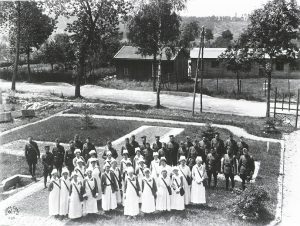
Nurses and doctors of St. Luke’s Hospital Evacuation Hospital No. 2
April 2017 is the 100th anniversary of the entry of the United States into World War I. Like many institutions in American society, the American hospital system and its doctors and nurses were rapidly mobilized to join the war that had been raging in Europe since the summer of 1914. The Mount Sinai Archives has now installed a display in the Annenberg Building north lobby outlining the activities of the hospitals in the Mount Sinai Health System.
In New York City, The Mount Sinai Hospital, St. Luke’s Hospital and The Roosevelt Hospital (today’s Mount Sinai West) all contributed to the war effort by establishing overseas units affiliated with their respective hospitals, and many doctors at Beth Israel Hospital volunteered individually. The records, photographs and correspondence on display in these cases reflect the experience of a war that defined a generation.
For the medical officers and administrators in charge of overseas hospital units, organizing effective hospital service on a scale never before seen was an immense logistical challenge. And for the individual doctors and nurses working with patients, who saw at close hand the terrible destruction inflicted by new methods of trench warfare and aerial combat, all while dealing with a world-wide pandemic of influenza, the war was an experience of medicine at its most fundamental, as they struggled under harsh conditions to relieve human suffering.
The items on display include images of the staff from the hospitals in their World War I roles; a scrapbook from Marion Moxham, a nurse from Ireland who joined with the Mount Sinai unit, Base Hospital No. 3; letters home from physicians to the Beth Israel Hospital administration; dog tags; a medal that was awarded to members of the Mount Sinai unit; images of the wounded and wards of St. Luke’s Evacuation Hospital no. 2 and a photo of the mascot of the Roosevelt Hospital group.











